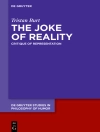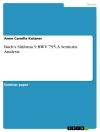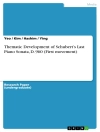Seminar paper from the year 2005 in the subject Musicology – Miscellaneous, grade: 2, University of Nottingham, course: Narrative and Emotion in Art and Music, language: English, abstract: In this essay, it will be tried to examine how lamentation in art and music is handled. The aim
will be to find out by which means lamentation is presented to the spectator and which kinds
of stereotypes are used in order to clarify the depiction of grief. First, it will be tried to explain
what the topic of lamentation is generally about, secondly, the case studies in which different
kinds of tragedies that include lamentations will follow. In the music section, it is necessary to
shortly summarize the plots of the analysed works to understand the full impact of the lament.
First, the worldly tragic love stories in no specific order will be the focus of investigation,
before the passion of Christ shall be examined. In the art section, scenes from the stories from
the preceding part of the work will be looked at, so that there is no need of retelling the plots. The terms lamentation and lament derives from the Latin word lamentum1 and can be equated
with expressions such as to mourn, to grieve, to wail, to moan, to weep and to cry. The term
lamentation is closely linked with the Italian term lamento that stands for a piece of music in
which somebody expresses his grief over something, mainly over another person’s death. The
term lamentation when referring to music means in the majority of cases “a vocal piece based
on a mournful text, often built over a descending tetrachord ostinato and common in cantatas
and operas of the Baroque period. Since the late 17th century also instrumental pieces with
wailing nature were sometimes named lamento, especially works by J. J. Frohberger and J. S.
Bach.2 Lamentation in art is represented just as good as in music: Since the medieval and
renaissance times one of the most often depicted topics is the “Lamentation over the Dead
Christ”. Painters, sculptors and other artist grew never tired of illustrating Christ and his
mourners, because of the importance of the incident of his death for the Christian community.
But not only Christians were depicted in the state of lamenting by the western artists, whose
paintings will be discussed later, mythological topics of mourning can be found as well. […]
1 Brockhaus– Enzyklopädie in 24 Bänden, (Mannheim, 181987), XIII, p. 21
2 Ibid.
Mareike Janus
Motives of Lamentation in Art and Music [EPUB ebook]
Motives of Lamentation in Art and Music [EPUB ebook]
Koop dit e-boek en ontvang er nog 1 GRATIS!
Taal Engels ● Formaat EPUB ● Pagina’s 31 ● ISBN 9783638352116 ● Bestandsgrootte 0.1 MB ● Uitgeverij GRIN Verlag ● Stad München ● Land DE ● Gepubliceerd 2005 ● Editie 1 ● Downloadbare 24 maanden ● Valuta EUR ● ID 3701367 ● Kopieerbeveiliging zonder












